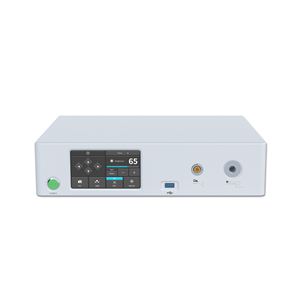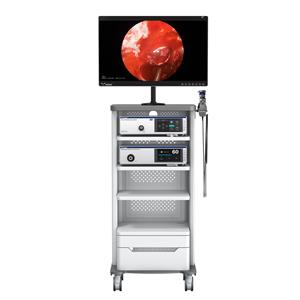Application of colposcopy in diagnosis of cervical cancer
The colposcopy is a magnifying speculum between the naked eye and a low-power microscope. After the continuous development of medical technology, there have been two major types of colposcopy, optical and digital. Colposcopy directly observes the morphological structure of the vascular epithelium on the surface of the cervix through magnification to assess the lesion, and has become the main method of cervical cancer screening and diagnosis.
Principles of colposcopy observation and diagnosis
The colposcopy observation mainly reflects the abnormality of the lesion with several signs of the surface configuration, border shape, color, blood vessel and iodine reaction of the cervical lesion.
The abnormal colposcopy images mainly include:
① Acetic acid white epithelium refers to the white patches that appear after acetic acid is applied, and the color of the surrounding epithelium before acetic acid is the same;
②Punctate blood vessels are composed of capillaries in the stromal mastoid ascending to the surface of the epithelium;
③Mosaic, mosaic-like blood vessels come from the matrix, and are basket-like surrounding the diseased epithelium in mosaic-like patterns;
④ Leukoplakia refers to the white plaque on the surface of the cervix, which can be seen under the colposcopy without applying acetic acid;
⑤ Abnormal blood vessels refer to the highly irregular diameter, shape and relationship of blood vessels, widening of the blood vessel distance, irregular contraction and expansion, sudden interruption and sharp turns, abnormal blood vessels are signs of invasive cancer;
⑥Iodine-negative area refers to the light brown or yellow after application of iodine solution, columnar epithelium, immature metaplastic epithelium, keratinized epithelium, and atypical epithelium are not colored as iodine test negative areas.
The severity of abnormal colposcopy images is determined by several factors. When abnormal intraepithelial cell nucleus volume increases, the cells undergo temporary dehydration after applying acetic acid, showing abnormal nucleoplasm ratio, cell nucleus hinders light transmission, and epithelium appears Turns white, the thicker the hyperplastic epithelium, the worse the degree of whiteness, or even the dark grayish white, the white degree of the epithelium is positively correlated with the severity of the lesion; the reduction of immature cell glycogen shows that the area remains uncolored after being coated with iodine solution; lighter lesions It is light and flat and a little fuzzy, and the boundary of the lesion is unclear; more severe lesions tend to be protrusions and lesions with obvious boundaries; and abnormal blood vessels are signs of the continuous development of the lesions. Whether the white epithelial protrusions are flat or fuzzy, the degree of whiteness and the boundaries are clear, and the distance between capillaries, etc. are closely related to the severity of the lesion.
Early diagnosis of cervical precancerous lesions with colposcopy
The colposcopy for those with suspicious or positive cytology can further determine the location and scope of the disease, achieve early screening, early diagnosis, and improve the cure rate. Colposcopy is an effective tool to screen for cervical lesions in asymptomatic women. The main purpose of colposcopy is to screen for precancerous lesions of the cervix and determine the scope or type of lesions. An experienced doctor will perform a biopsy on the most obvious abnormalities in the cervical transition zone, which can increase the specificity and sensitivity of the biopsy. The images of CIN displayed under the colposcopy can be varied, most of which are acetic white epithelium, which can appear alone or simultaneously with images such as punctate areas and (or) mosaics. Colposcopy is a valuable screening method for diagnosing CIN and cervical cancer.
The combination of colposcopy and cytopathology improves the accuracy of diagnosis
Cytology and colposcopy are two complementary inspection methods. Cytology is a laboratory diagnostic method that evaluates the occurrence and development of lesions through morphological observation of cervical exfoliated cells; colposcopy is a clinical diagnostic method that directly observes the blood vessels and morphology on the surface of the cervix to evaluate lesions. As a screening tool, colposcopy can significantly reduce false negatives in cytology. The low specificity and false positives of colposcopy can be overcome through the identification of colposcopy images and technical training. Colposcopy is easy to miss the diagnosis of small lesions, and the missed diagnosis is related to the size and location of the lesion. Cervical canal lesions are difficult to observe. Cervical canal dilator should be used to expose cervical canal for observation. If necessary, cervical canal curettage should be performed. Misdiagnosis of cytology is mostly in low-grade lesions, which has nothing to do with the size of the lesion, but is related to the extent of the lesion. Colposcopy can correct false-negative cytological results.
Colposcopy-guided positioning biopsy improves the accuracy of early diagnosis
The conventional four-point biopsy of the cervix has a certain degree of blindness, with an accuracy rate of only 50%, which can easily lead to missed diagnosis and misdiagnosis. Observation of the fine structure of the cervix through the colposcopy and the positioning under the microscope to make the biopsy target more accurate can significantly increase the positive rate of the biopsy. Observing the morphology and structure of the cervix under colposcopy can distinguish the nature of its lesions, avoid unnecessary biopsy and cervical conization, and reduce excessive treatment.
Colposcopy can be used as a tool for observation and long-term follow-up of lesions
The colposcopy is a non-invasive examination, and the patient has high compliance. It can dynamically observe the development process of the disease and pay close attention to the changes of the disease. Treatment of precancerous lesions of the cervix under colposcopy, such as cervix electrosurgical excision (LEEP), can provide clear lesion boundaries, ensure the success of the operation, reduce residual lesions after surgery, and be used as a tool for long-term follow-up after treatment. Vagina within 2 years after surgery Microscopy combined with cytology can achieve a higher detection rate, make future follow-up plans more relaxed, and reduce the risk of losing follow-up in the future.




